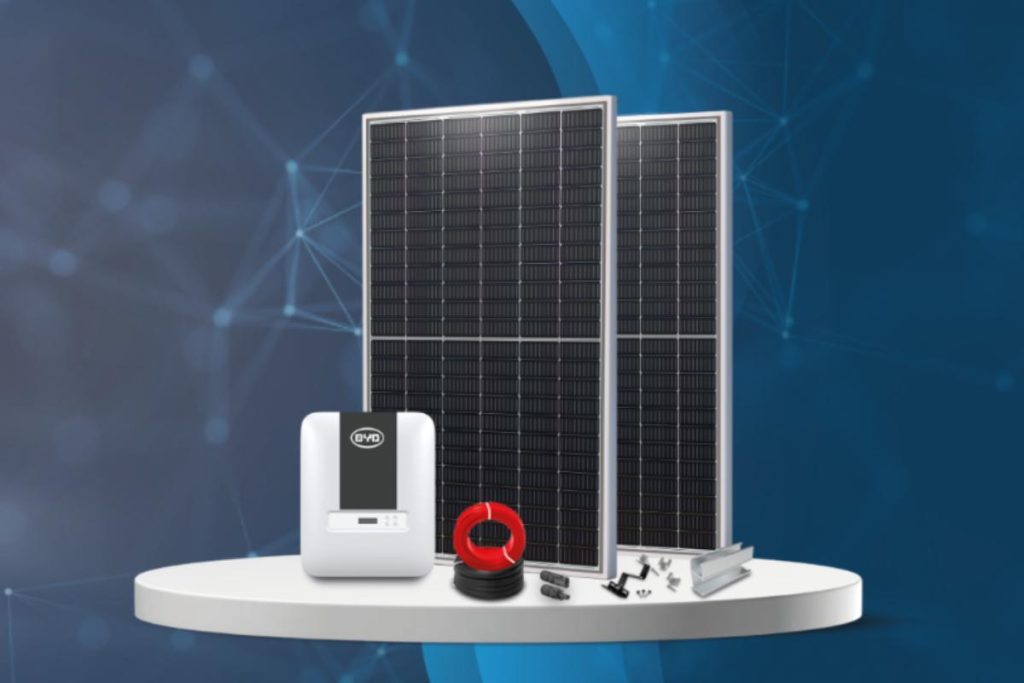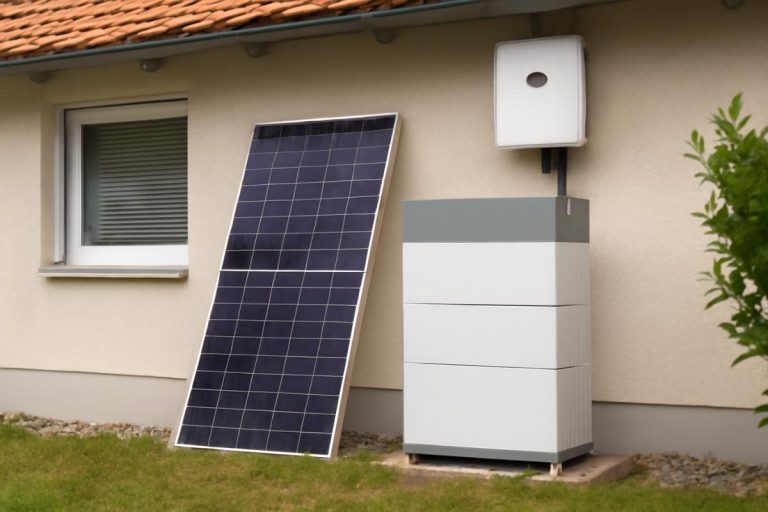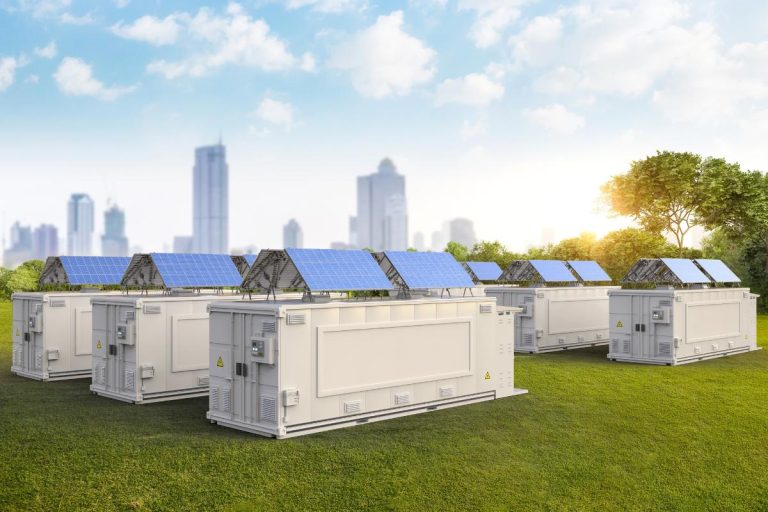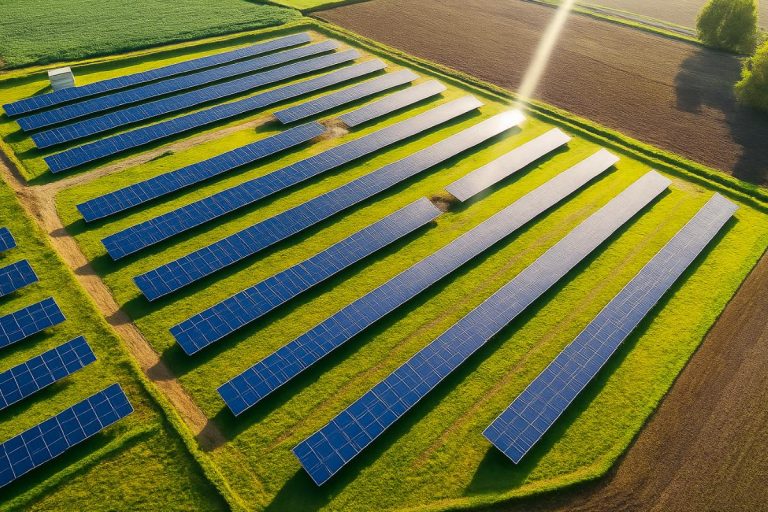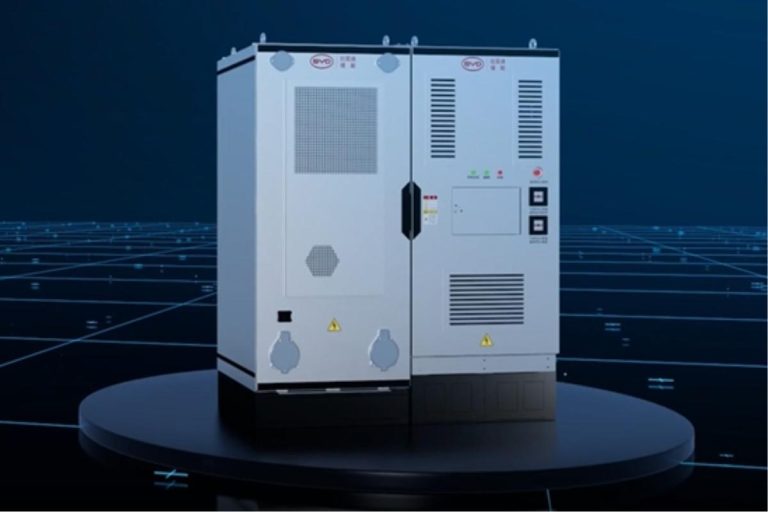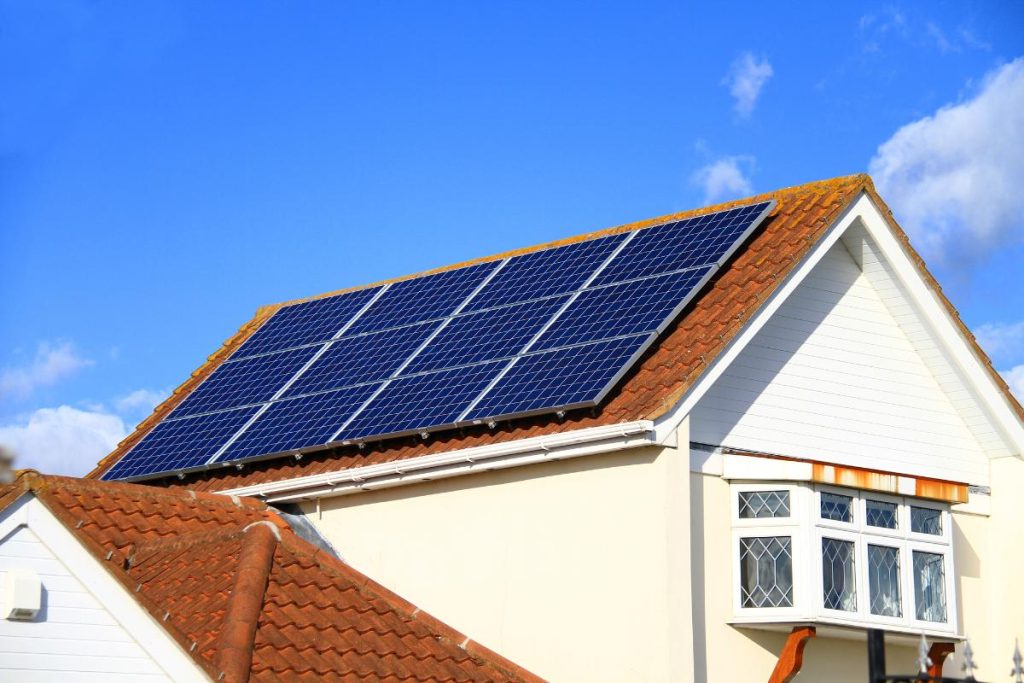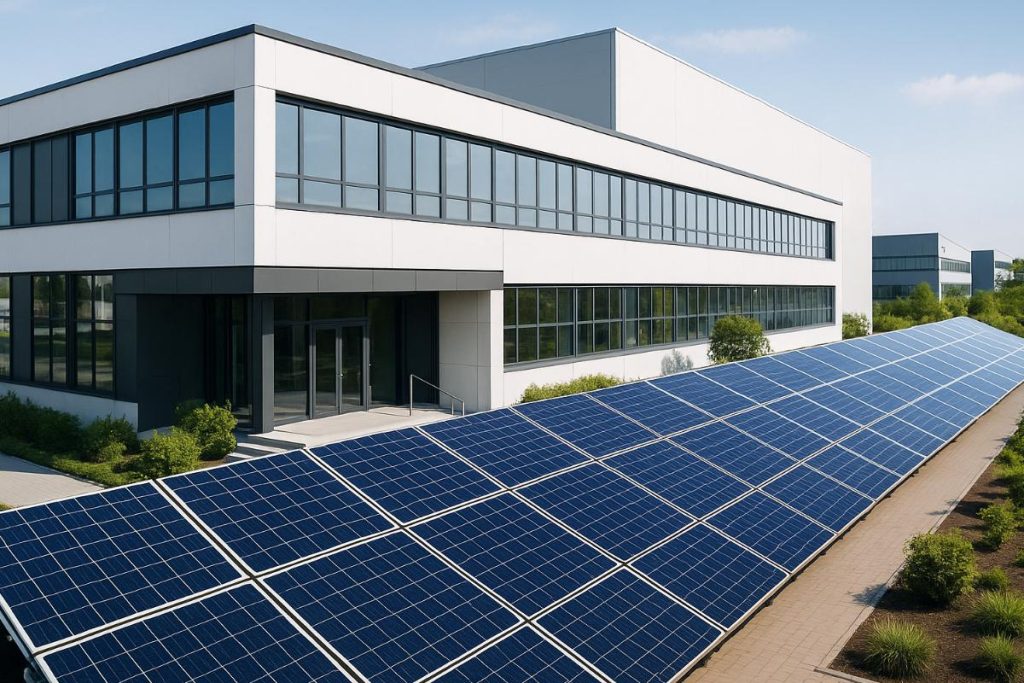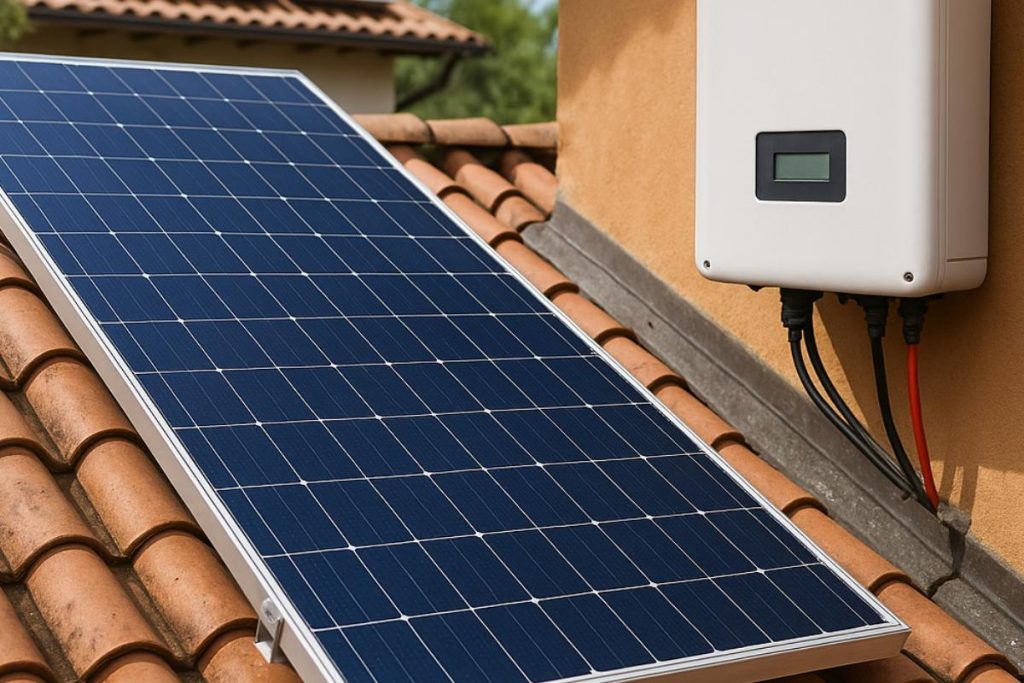One photovoltaic kit is a complete solution for those who want to generate solar energy, bringing together all the necessary equipment in a single package. Instead of buying panels, inverters and other items separately, the kit comes with solar panels, inverter, fixing structures, cabling and protection sized to work together. This makes life easier for those wishing to install a photovoltaic system, ensuring compatibility between components and easier installation. What's more, opting for a complete kit can be cheaper than buying piece by piece, not to mention the convenience of a single supplier and unified support.
A photovoltaic kit includes solar panels, inverters, structures and other components needed to generate clean energy in your home or business.
What's in a photovoltaic kit? How does it work?
A typical photovoltaic kit consists of several essential components which together make it possible to capture sunlight and convert it into usable electricity. See the main items included and their functions:
- Solar panels (photovoltaic modules): are the heart of the system. They capture the energy from the sun and convert it into electricity through the photovoltaic effect on the silicon cells. The number and power of the panels determine the kit's generating capacity.
- Solar inverter: equipment that converts direct current (DC) generated by the panels in alternating current (AC)which is the form of energy used by appliances and the electricity grid. The inverter also monitors the system and ensures that the solar energy can be safely injected into the grid or used at home.
- Fixing structures: set of supports, profiles and fasteners for installing solar panels on the roof, ground or other surfaces. They are designed according to the type of roof (ceramic, metal, asbestos cement) or floor mounting, guaranteeing firmness and the proper inclination of the modules.
- Cabling and connectors: special electrical wires and MC4 connectors that link the panels, the inverter and the switchboard. They are sized to withstand the electrical current generated, with appropriate insulation and minimal loss, guaranteeing safety and efficiency in the transportation of energy.
- String box and electrical protections: junction boxes (DC and AC) containing protection devices, such as circuit breakers, fuses and SPD (surge protection devices). These protections prevent overloads, short circuits and damage to the system in the event of voltage spikes or lightning strikes.
- Batteries (optional): present in kits off-grid or hybrids, batteries store solar energy for use at night or in emergencies. They are usually lithium batteries (such as BYD's high-efficiency LFP batteries) due to their long service life and safety. They provide energy autonomyThis guarantees electricity even when the sun is out or during blackouts.
Each of these components plays a fundamental role in the operation of the kit. During the day, the panels generate direct current electricity; this energy is sent to the inverter, which transforms it into alternating current compatible with the home's grid. If there is consumption at the time, the solar energy feeds directly into the electrical equipment.
If the panels generate more than immediate consumption, the surplus can be injected into the electricity grid (in the case of grid-connected systems, generating credits) or stored in the batteries from the system, when present. At night or on cloudy days, a kit connected to the grid will draw energy from the utility as normal; in kits with batteries, the accumulated energy is used to supply demand.
This whole process takes place automatically and silently, monitored by the inverter. The result is clean and free energy from the sun, drastically reducing electricity bills and dependence on conventional electricity.
What are the types of photovoltaic kit (on-grid, off-grid and hybrid)?
There are different types of photovoltaic kitsThese systems are suitable for different needs. The main distinction lies in how the system integrates (or not) with the public electricity grid and whether there is energy storage. There are three main categories:
On-Grid Kit (connected to the grid)
This is the most common type in homes and businesses. The on-grid system works in parallel with the utility: during the day, it generates solar energy and supplies local consumption; if it produces a surplus, it injects it into the electricity grid, converting it into credits (in Brazil, via a compensation system). net metering). At night or during periods of low generation, the property consumes electricity from the grid as normal.
This kit no batteriesIt doesn't store energy, so it relies on the grid when there's no sun. The advantage is the lower cost (because it doesn't include batteries) and simplicity. A current inverter The smart kit synchronizes solar energy with that of the utility company, ensuring that all electrical appliances work without interruption. This type of kit is ideal where there is a reliable supply from the distributor and allows you to reduce your electricity bill by up to 95%, since practically all the energy consumed comes from the solar panels when it is sunny.
Off-Grid Kit (stand-alone)
Suitable for locations no access to the electricity grid (remote sites, cabins, boats) or for those seeking total independence from the utility. The off-grid system operates in isolation and requires batteries to store the energy generated during the day and use it at night or on cloudy days. It includes the panels and the appropriate inverter (off-grid or hybrid inverter), load controllers to manage the charging/discharging of the batteries.
With the batteries, the off-grid kit guarantees a continuous supply even without sunlight, offering complete autonomy. This model provides security against power outages: even when there are blackouts in the area, the property is still powered. For this reason, many businesses that can't afford to stop opt for systems with batteries in order to have a complete autonomy. backup in the event of network failures. The downside is the higher initial cost - batteries and additional equipment make the kit more expensive - and the need for precise sizing, taking into account the desired consumption and days of autonomy. Even so, with technological developments, batteries have become more affordable (according to the IEA, prices have fallen by around 90% in the last 15 yearsmaking storage an increasingly viable option). This has increased interest in battery systems, especially after blackout events that caused damage, as stored solar energy offers a greater potential for energy efficiency. electrical safety and independence to consumers.
Hybrid Kit
It's a combination of the previous two. In this system, the panels are connected to the grid e to a battery bank. In other words, it works as an on-grid system on a day-to-day basis (being able to inject surplus into the grid), but it also stores energy in batteries for use in the event of a power outage or at peak times.
Under normal conditions, the priority is to supply consumption and charge the batteries; if there is extra, it goes to the grid. If the grid goes down, the hybrid inverter disconnects from the utility and starts powering the house using the stored energy (this happens instantly, so the house doesn't even feel the lack of light).
The hybrid kit offers the best of both worlds, maximum savings on electricity bills and resilience against blackoutsBut with a higher investment due to the batteries. It's a great option for those who live in areas with unstable supply or for businesses that can't suffer interruptions (IT equipment, offices, etc.). It's worth noting that BYD's modern hybrid inverters, for example, already come with a backup function and can operate in both modes automatically, providing a great deal of flexibility.
In terms of application, we can also classify kits by size: kits residential, commercial/industrial and kits for large plants. This classification basically concerns system power. BYD offers kits of various sizes, starting at around 2 kWp (enough for a low-medium consumption home) up to kits of tens of megawatts for solar farms. Regardless of the size, the operating principles are the same, what changes is the amount of equipment. A typical home uses kits of between ~2 and 8 kWp; medium-sized businesses and companies, kits of between 10 and 50 kWp; while industries and power plants can require hundreds of kWp or a few MW. In practice, sizing the right kit involves analyzing monthly energy consumption (in kWh), installation conditions (space available for panels and solar incidence) and deciding whether or not to have battery storage. In the next topic, we'll talk about costs of these kits and how you can estimate the investment required.
How much does a photovoltaic kit cost?
Price is one of the first questions asked by anyone researching solar energy. The cost of a photovoltaic kit varies depending on the power of the system (number of panels), the brand and quality of the equipment and whether it includes batteries or not. To give you an idea, here are some examples of residential on-grid kitsconsidering only the main equipment (without installation or extras), with average values updated to 2025:
- 2 kWp kit (about 4 panels) - approximately R$ 7,000 to R$ 8,000
- 4 kWp kit (approx. 8 panels) - approximately R$ 11,000 to R$ 12,000
- 8 kWp kit (approx. 16 panels) - approximately R$ 19,000 to R$ 20,000
- 12 kWp kit - approximately R$ 27,000
(Estimated average values; may vary according to region and suppliers. Does not include installation labor).
For larger systems (commercial or industrial), the cost increases in proportion to the capacity. For example, a solar kit for a small business can cost between R$40 and 80,000, while an industrial solar plant can easily exceed R$100,000. However, it's important to remember that these investments pay for themselves in a few years through savings on electricity bills.
In many residential cases, the payback (return on investment) occurs in about 5 to 7 yearsThis can be even faster for businesses, thanks to higher energy bills (where the monthly savings are greater). Considering that the panels last 25 years or more, all the energy generated after the payback period is profit, practically free energy for the remainder of the system's useful life.
Check out our article: Value of solar energy
How much do the off-grid kits cost? Systems with batteries tend to have a higher initial cost due to the price of the accumulators. A complete residential off-grid photovoltaic kit, sized to generate up to ~10 kWh/day, costs around R$ 17 thousand to R$ 20 thousand on the market, including panels, an off-grid inverter, a charge controller and a modestly sized battery bank. This figure can rise considerably for larger systems, as batteries for storing large amounts of energy are still expensive components. In any case, battery prices have been falling in recent years and there are already financing lines This means that even though the investment in a kit with storage is higher, it can be offset by the benefits: not only do you save on electricity, but you also gain money. In other words, even if the investment in a kit with storage is higher, it can be made easier and outweighed by the benefits: in addition to saving on electricity, you get protection against blackouts and fluctuations of the network, avoiding damage and disruption.
Important: the values above do not include installation. The photovoltaic kit is usually sold without the design and labor services. To get it up and running, you'll need to hire a professional or specialized company to do the work. electrical designthe installation of the equipment and commissioning (configuring and connecting the system to the utility's network, where applicable).
Many suppliers offer the kit + installation as a package, so it's worth doing some research. But if you've bought a kit yourself, don't try to install it yourself unless you have electrical experience, look for an accredited installer. This guarantees the safety of the system and validates the warranty on the products. Partner companies (solar integrators) can take care of everything, including the bureaucracy of connecting to the utility. A BYD EnergyFor example, it has a network of partners throughout Brazil who can help with everything from sizing to complete installation, delivering the solar plant ready for use.
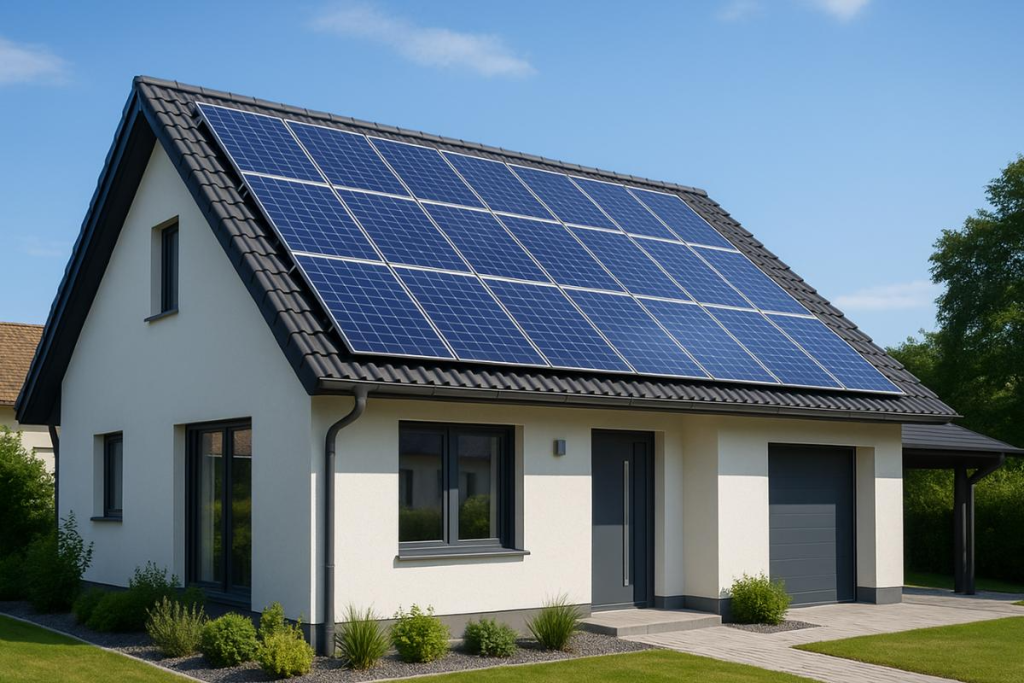
How to choose the right photovoltaic kit?
Faced with so many options in terms of size and configuration, how do you decide which solar kit is right for you? Below, we've listed the main aspects you should evaluate when making your decision. best choice:
- Your energy consumption: It all starts by analyzing your electricity bill. Check the average monthly consumption (in kWh) of your home or business, this information is described on the bill. The photovoltaic kit must have enough capacity (in kWp) to generate a monthly energy close to this value. For example, if your home consumes ~300 kWh/month, a ~2.5 kWp kit could do the trick (considering good solar incidence). For 600 kWh/month, perhaps 5 kWp, and so on. A designer can help with the exact calculation, taking into account the solar irradiation in your region and the system's losses. But as a simple rule: each 1 kWp of panels generates around 120 to 180 kWh per monthdepending on your location. Then estimate how many kWp you need and choose a kit with close power. Remember to consider possible future increases in consumption (e.g. buying air conditioning, extra appliances or electric vehicles). Many people opt for a slightly larger kit already thinking about the growth in demand, taking advantage of the fact that the installation will only be done once.
- Space available for installation: Check if you have sufficient area to accommodate the necessary solar panels. Small kits (up to 3 kWp) fit on most residential roofs without problems. Kits of 5 kWp or more require a larger area. On average, each 1 kWp panel takes up 5 to 7 m² of space. In addition to space, assess the orientation and slope of the roof: ideally, the panels should face north (in the southern hemisphere) and not be shaded during the day. If roof space is limited, you may have to opt for more efficient panels (higher wattage per square meter) or reduce the generation target. In cases of lack of space or too much shading, consider installation on the ground or special structures (such as a garage roof), carportetc., as BYD kits offer solutions for various types of structure).
- Connected to the network or stand-alone: Decide between an on-grid, off-grid or hybrid kit based on your storage needs and the reliability of the local grid. If you live in an urban area with a stable grid and just want to save money on your bill, the on-grid kit will be sufficient and more economical. If your area suffers a lot of blackouts or if you can't afford to be without power (home office, medical equipment, business), it might be worth investing in a hybrid kit with batteries to back it up. If you don't have electricity from the utility company (in a remote rural area, for example), the off-grid kit is the only option, size the batteries to meet demand. Remember: including batteries is expensive, so evaluate the cost-benefit ratio. Today there are modular batteries that allow you to start with an on-grid kit and add storage in the future (in the case of hybrid inverters). BYD, for example, has modular lithium iron phosphate batteries (Battery-Box Line) that can be integrated later if the customer wants to expand the system to hybrid.
- Quality of equipment and guarantees: Not all kits on the market are the same - quality differences can impact both the performance and durability of the system. Choose recognized and reliable brands. Check the efficiency and certifications of the panels (e.g. tier 1 modules, with a 25-year linear performance guarantee), check that the inverter has a national guarantee and local technical assistance, and that the structures and accessories comply with standards. A BYD stands out for manufacturing its photovoltaic modules in-house with advanced technologies (PERC, TOPCon) and offering a 25-year power guarantee, as well as inverters with local support. A photovoltaic kit is a long-term investment, so it's worth paying a little more for superior equipment that will give you fewer headaches. Also check that the kit includes all the necessary items (some cheap kits may omit some component to reduce the price, requiring a separate purchase later).
- Supplier and support: Give preference to purchasing your kit from companies or programs that offer technical and after-sales support. One benefit of buying complete kits from established manufacturers (such as BYD) or authorized distributors is that you can count on unified guarantee and specialized support for all the kit's components. For example BYD photovoltaic kits come with a full equipment warranty directly from BYD and its service network, which gives you much more peace of mind in the event of any problems. In addition, these companies usually appoint qualified installation partners to carry out the service, increasing the safety of the project. Avoid kits of dubious origin or sellers without references - problems with solar equipment can take years to appear, so the solidity of the supplier matters.
- Price and payment terms: Finally, look for quotes and compare prices, but with a critical eye. The cheapest kit may not be the best if you sacrifice quality. Look at what each kit includes, calculate whether a slightly larger model would compensate for the extra generation, and find out about financing options and incentives. Many banks already have green credit lines for solar energy with low interest rates and payments over up to 5 years (some installments start after 120 days, as in the BV financing program). Also check for local tax incentives (some states exempt compensated energy from ICMS, for example). Negotiate with your chosen supplier, sometimes it's possible to get a discount or gift (such as extra monitoring) when you buy the whole kit.
By following these steps, you will be able to identify the ideal photovoltaic kit for your energy demand and budget. Remember to always consult trained professionals to validate the sizing and design of the system. Solar energy is a modular and scalable solution, so start with what is feasible now, knowing that in the future you can expand capacity by adding more panels or batteries. The important thing is to take the first step towards energy independence and the sustainable economy!
Is it worth buying a complete photovoltaic kit?
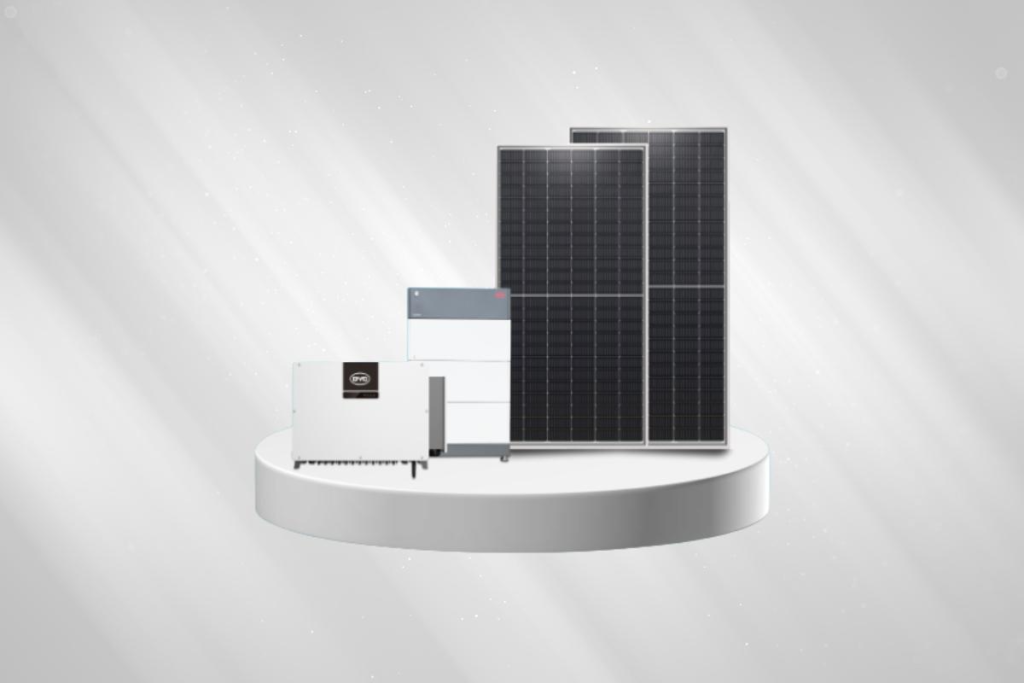
Yes, and for various reasons. Opting for a complete solar kit instead of buying the components individually brings clear advantages, especially for those who don't want a headache in the process. The main benefits include:
- Ease and convenience: with a kit, you get all items at once. You don't have to search for and buy each part separately (panels from one manufacturer, inverter from another, etc.), which avoids incompatibilities. You save time and effort by receiving an integrated package ready for installation.
- Compatibility guaranteed: the components of a kit are designed or selected to work perfectly together. This means that the power of the panels is dimensioned for that inverter, the cables support the appropriate current, the structures support the number of modules, etc. The risk of specification errors is reduced. A "frankenstein" system assembled with random parts can have performance problems if there is no harmony.
- Unified support and warranty: perhaps the biggest asset. When you buy everything from the same supplier/manufacturer, you usually have unique guarantee covering the entire system and a centralized support channel. If any problems arise, you know where to turn. This is much better than, in the event of a failure, having each component manufacturer blame the other. For example, a BYD kit comes with BYD's own warranty and service for modules, inverter and other parts, making it much simpler for the customer.
- Cost-effectiveness (discounts): suppliers usually offer more competitive prices in complete kits. It's more cost-effective to buy the package than to add up each individual item. There are economies of scale and often special promotions or discounts for kits (for example, free shipping or a lower price per watt installed). In addition, some kits include extra items such as structures and protections at no extra cost, which you might forget to account for when buying separately.
- Optimized installation: complete kits usually come with installation manual and even remote technical support to help the electrician/installer. As it is a standardized kit, assembly tends to be quicker and with fewer unforeseen problems. In some cases, companies sell the kit already including installation in the package - so in a few days you're up and running with solar energy, no surprises.
- Up-to-date technology: major suppliers are constantly updating their kits with the more modern models of equipment. By purchasing a reference kit, you can be sure of receiving up-to-date and compatible equipment, rather than running the risk of buying an obsolete or unsuitable component in isolation.
In summary, the complete photovoltaic kit is worthwhile mainly for the tranquility it provides. For those who want to get into solar energy without becoming an expert in the field, this is the recommended option. Of course, assembling a system piece by piece can offer flexibility for enthusiasts, but most people, and professional integrators, prefer the integrated solution for its low risk and high practicality. The small extra cost you may pay is easily offset by the advantages listed. So, if you want to safety, ease and guarantee of results, investing in a complete solar kit from a reliable supplier is a great way to go.
Frequently asked questions about photovoltaic kits
Is a photovoltaic kit really worth it?
Absolutely. A photovoltaic kit allows you to produce your own energy and save up to 90% on your electricity bill with a clean, renewable source. Despite the initial investment, it pays for itself in a few years through the monthly savings generated. It also adds value to the property and protects against tariff increases in the future. Today, kit prices are more affordable and there is easy financing for solar energy, making the project viable for many people. When properly sized and installed, a photovoltaic kit lasts 25 years or more, generating electricity practically for free after the return on investment. In other words, it's worth it for the relief in your pocket and the energy autonomy it provides, not to mention the environmental benefits of using solar energy.
How do I know which solar energy kit to buy for my home?
To choose the ideal kit, first evaluate how much energy you consume (see your electricity bill in kWh/month). This is the starting point for sizing up the power (kWp) required from the kit. Next, consider the available space on your roof or land to install the panels, this may limit the size of the system.
Decide if it will be on-grid or off-gridIn the city, on-grid is usually sufficient, but in isolated locations or with an unstable network, a kit with batteries may be better. Research trusted brands and prefer kits from suppliers that offer a comprehensive warranty and technical support.
A good tip is to look for specialized companies (solar integrators) that do a personalized analysis: they will calculate the right kit for your home, taking into account consumption, location and objective (maximum savings or autonomy). In short, the best kit is the one tailored to your energy needs, with quality components and guaranteed support. There is no one-size-fits-all kit, so rely on professional help to define yours.
What's the difference between buying a complete photovoltaic kit and buying the components separately?
The main difference is in convenience and security of investment. When you buy a complete kit, you already receive all the correct and compatible equipment, usually with a single guarantee certificate covering everything. This avoids specification problems (like buying an undersized inverter for the panels, for example) and makes it much simpler in the event of a fault - you'll have a single technical support team to call on. Buying the components separately, on the other hand, leaves you with the task of selecting each item, which requires technical knowledge to ensure that everything works together.
You will also have separate warranties for each part (panels, inverter, etc.), possibly from different manufacturers, and in the event of a problem one can pass the buck to the other. In terms of costoften the complete kit costs cheaper overall (manufacturers give volume discounts), while buying piece by piece can add up to a higher price, not to mention multiple shipments.
The only reason to buy separately would be to assemble a customized system outside of the available standards, yet most integrators prefer base kits and make minimal adjustments. Therefore, for 99% of the cases, the complete photovoltaic kit is the most practical, economical and safe option, especially for those starting out in solar energy.
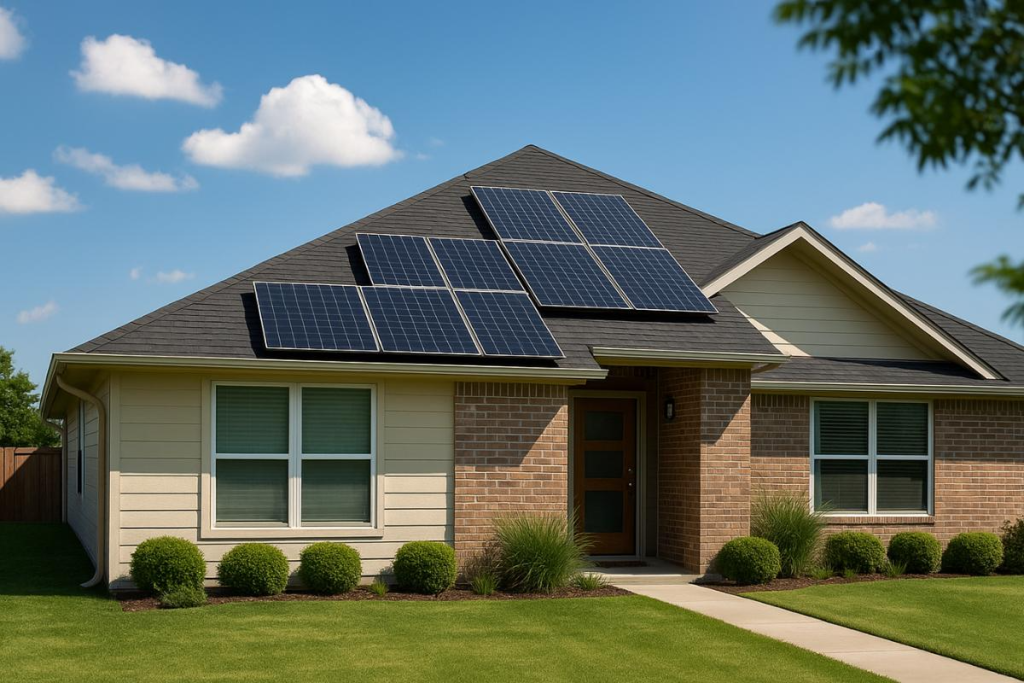
Easy solar energy with BYD photovoltaic kit
Adopting solar energy has never been easier. The photovoltaic kits deliver into your hands everything necessary to start the generate your own clean energy and save money. As we have seen, a well-chosen kit brings excellent financial returns, independence from the electricity grid and contributes to a sustainable future. When it comes to taking this step, rely on solid partners and quality products. A BYD, a global leader in energy solutions, offers complete photovoltaic kits with state-of-the-art technology, including high-efficiency panels, reliable inverters and optional state-of-the-art batteries, all with specialized technical support and a factory-direct guarantee.Are you ready to turn sunlight into savings for your pocket? Request a quote for a complete BYD solar kit now and discover the solution tailored to your needs. Our team will be happy to prepare a personalized project and answer all your questions, from financing to installation. Harness the power of the sun to your advantage and join the clean energy revolution! Start generating renewable energy today and reduce your electricity billThe sustainable energy future is within your reach. Order your photovoltaic kit here.

